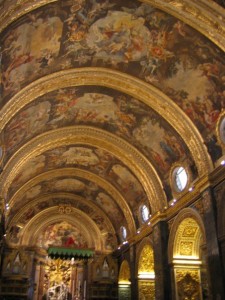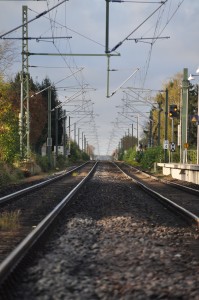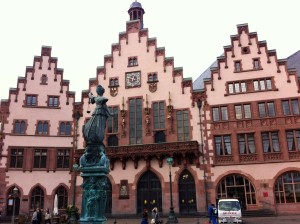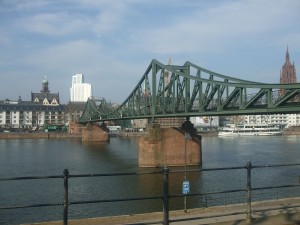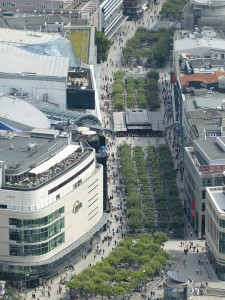I’ve mentioned in other posts that my trip to Malta sprang from one of my core travel philosophies – if you know someone in an interesting, far away place that you might never otherwise have occasion to visit, pack your bags and go for it. October, 2007 was an interesting time to be in the archipelago nation. (Rather than being a single island as is commonly believed, Malta is actually comprised of three inhabited islands and a number of smaller, rocky outcrops). The country was frantically preparing for further assimilation into the EU, with unmanned Schengen immigration counters already set up at the Malta International Airport, and a countdown clock by Valetta’s City Gate marking the days, hours, and minutes until the Euro would be officially adopted. (Frankly, I was delighted to still be able to use the Maltese lira!) Note that this adventure is eight years old – but general itinerary items should still be doable!
As my plane descends, I find myself faced with scenery unlike any I’ve ever seen before. Yellow walls and grey walks rocks with only the slightest hint of scrubby vegetation extend as far as the eye can see. The sea is a beautiful and almost mysterious shade of deep blue. And I can see the entire island nation from the sky!
Theme I: A Tale of Two Cities
Mdina
As the only person with Asian features in the airport I am highly amused by the fact that I spot my friends Greg and Marco – who look almost exactly like everyone else – before they see me. A diplomat well-versed in the perils of jet lag, Marco sits firmly in the “fight through it” camp. Plunking my luggage in the trunk, he heads straight for Mdina, the Silent City.
Almost entirely carless, Mdina is the perfect place to lose yourself, meandering through narrow alleys for a couple of hours. We briefly pop into St. Paul’s Cathedral, built on the spot where then governor and now Maltese saint Publius allegedly met St. Paul after he was shipwrecked on Malta. We also visit Palazzo Falson, a wonderfully preserved medieval palace. Noting that I am flagging after a couple of hours soaking up the admittedly marvelous atmosphere, he marches our trio to a small café, where we met up with some of their friends. (I discover throughout the trip that it is almost impossible to go anywhere on the island without bumping into at least one person you know!)
Dining at home with Greg, Marco, and some of their friends, I alternate devoting all of my energy trying not to fall asleep on my plate with peppering the local Maltese experts with all sorts of questions about the seemingly impossible, consonant-filled Maltese language, and the intersection of Arab, Roman, and English cultures.
Valetta
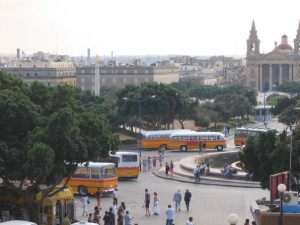
Maltese buses! If you watch the movie Munich, you’ll notice these buses in the background in “Jerusalem” and “Rome”
The next morning, Greg and I hop on a wonderfully quaint orange Malta bus (sadly but perhaps practically discontinued in 2011) to Valetta. Our first stop is St. John’s Co-Cathedral, quite possibly the most beautiful and ornate house of worship I have ever seen. And that is really saying something given my lifetime of travel across the globe.
I am surprised to discover that I am absolutely FASCINATED by the Knights of Malta – or more accurately, the Sovereign Hospitaller Order of the Knights of St. John of Jerusalem, of Rhodes and of Malta. One of the reasons that the church is so over-the-top amazing is that each group of knights tried to outdo the next through ever expanding contributions. The talented but hot-headed Caravaggio also had a rather checkered history on the island.
We head to Valetta’s Church of Saint Paul’s Shipwreck (I’m learning that this maritime disaster is a BIG deal in Malta!). While there is no comparison from a grand aesthetic/architectural point of view – it’s a truly lovely example of traditional Maltese baroque architecture and is both calm and inviting.
We stroll through the Upper Barrakka Gardens where we enjoy stunning panoramic views of the Grand Harbor. Greg jokes that we have missed the Saluting Battery, and says that for some reason he always seems to arrive minutes too late. While it would have been cool to see, I must admit that I greatly enjoy the peace.
We end the day browsing among local artisans making filigree jewelry on Republic street – and being me, I can’t resist picking up a pair of silver earrings to adorn myself and commemorate the trip.
Theme II: Megalithic Marvels
The Hypogeum of Ħal-Saflieni (severe claustrophobes beware)
Greg and Marco are good friends and have booked my admission to the Hypogeum of Ħal-Saflieni in advance (a MUST as daily admissions are strictly limited to reduce the impact on the fragile environment). The aptly-named Hypogeum (Greek for underground) is at once incredibly cool (both literally and figuratively!) and somewhat creepy (it is a necropolis after all!) While it is not known exactly when the structure was built, historians’ estimates range from 4000-3000 BC. The tour is a bit rushed, but certainly interesting – particularly when you consider how old it is! While I am generally not one for random knickknacks, something about the prone image of the rotund and wonderfully detailed Sleeping Lady of Ħal-Saflieni speaks to me, and I pick up a replica at the gift shop.
Megalithic Temple
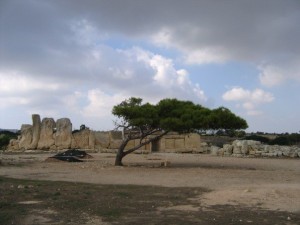 We begin at the Tarxien temples, site of 4 temples built between 3600 and 2500 BC. Marco explains that as a child he and his friends would play among the giant “rocks” without realizing their historic significance. I am amazed at how well preserved some of the relief sculptures are, given their age. Our special next stop is Hagar Qim “Close your eyes,” said Marco with a gleam in his eye. Gently taking me by the shoulders, he guides me to a nondescript rock. Bending my knees down to “just the right angle,” he explains that this was the exact vantage point that a renowned National Geographic photographer chose to capture the UNESCO World Heritage Sites, in all its glory. (Note, some of the megalithic temple sites have been closed for renovation at various times over the past few years, so do comprehensive research first to avoid disappointment!) At the temple site of Mnajdra, my friend Greg proudly poses for me to provide perspective – either he is really tall (which he isn’t. . .) or, more accurately, the megalithic peoples were vertically challenged! It is humbling to realize the lasting accomplishments of these long-gone civilizations from millennia ago, and one can’t help but wonder what, if any, impact we will leave for the future.
We begin at the Tarxien temples, site of 4 temples built between 3600 and 2500 BC. Marco explains that as a child he and his friends would play among the giant “rocks” without realizing their historic significance. I am amazed at how well preserved some of the relief sculptures are, given their age. Our special next stop is Hagar Qim “Close your eyes,” said Marco with a gleam in his eye. Gently taking me by the shoulders, he guides me to a nondescript rock. Bending my knees down to “just the right angle,” he explains that this was the exact vantage point that a renowned National Geographic photographer chose to capture the UNESCO World Heritage Sites, in all its glory. (Note, some of the megalithic temple sites have been closed for renovation at various times over the past few years, so do comprehensive research first to avoid disappointment!) At the temple site of Mnajdra, my friend Greg proudly poses for me to provide perspective – either he is really tall (which he isn’t. . .) or, more accurately, the megalithic peoples were vertically challenged! It is humbling to realize the lasting accomplishments of these long-gone civilizations from millennia ago, and one can’t help but wonder what, if any, impact we will leave for the future.
Theme III: Color in Nature
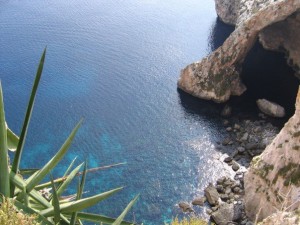 I mentioned being struck by colors at the beginning of this post – and indeed, my sensory exploration continued during the latter part of my trip. The Blue Grotto, a sea cave on the southern coast of Malta, was one such place. Now while one might im
I mentioned being struck by colors at the beginning of this post – and indeed, my sensory exploration continued during the latter part of my trip. The Blue Grotto, a sea cave on the southern coast of Malta, was one such place. Now while one might im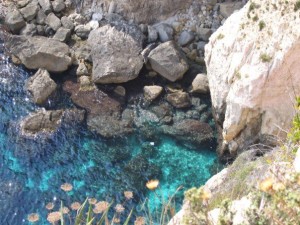 agine the water itself to provide the luminescent blue tinge, but it is in fact the pure white sand that lends the area its unique hue. And it’s not just the water. The cave itself is home to a veritable rainbow of colors – from bright mineral yellows and oranges to deep purples, and a variety of submerged fauna.
agine the water itself to provide the luminescent blue tinge, but it is in fact the pure white sand that lends the area its unique hue. And it’s not just the water. The cave itself is home to a veritable rainbow of colors – from bright mineral yellows and oranges to deep purples, and a variety of submerged fauna.
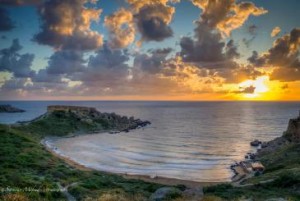 We end the day with some relaxation at Għajn Tuffieħa beach, a quiet beach and steep hike down to a crescent shaped promontory that is TOTALLY worth it – especially at sunset. Enjoying our relaxed states, we proceed to an outdoor restaurant at The Three Cities to enjoy first hand Malta’s maritime history coming to life.
We end the day with some relaxation at Għajn Tuffieħa beach, a quiet beach and steep hike down to a crescent shaped promontory that is TOTALLY worth it – especially at sunset. Enjoying our relaxed states, we proceed to an outdoor restaurant at The Three Cities to enjoy first hand Malta’s maritime history coming to life.
Believe it or not I never made it to Gozo, a much less developed island that is renowned for its own charms. No worries though – it provides me an EXCELLENT reason to return. . .







